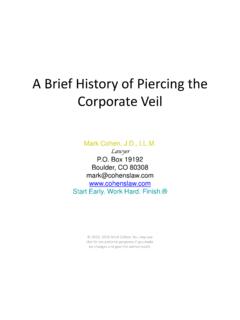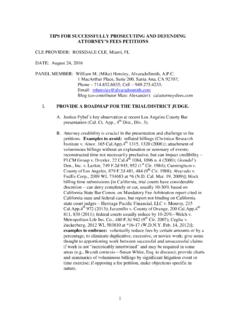Transcription of A. UNIFORM FRAUDULENT TRANSFER ACT (UFTA
1 1 The Role of FRAUDULENT Conveyances in Collection Matters A. UNIFORM FRAUDULENT TRANSFER ACT (UFTA) Congratulations, you have just won a final judgment for your client. You were sure to have it conclude with the magic words, for which let execution issue. Unfortunately, your work is not yet finished. You now have to collect on the judgment, and in the event the judgment debtor is now or has been attempting to rid himself of his assets you are going to have to set aside those transfers. The UNIFORM FRAUDULENT TRANSFER Act of 1984, 11 USCA 548 et seq. has been adopted by 44 While it was originally designed to protect a debtor s estate from exhaustion by creditors,2 it has been used to set aside transfers by debtors who use those transfers to fraudulently defeat claims by creditors.
2 In a typical FRAUDULENT scenario, a debtor will TRANSFER an asset or incur a debt. To set aside the TRANSFER the creditor must prove the TRANSFER was made with the intent to defeat the claim of a creditor. The claim can arise either before or after the TRANSFER if the TRANSFER was fraudulently made. In the instance of pre- TRANSFER creditors, the creditor need only show badges of fraud to establish an inference of fraud, whereas post- TRANSFER creditors must show fraud in fact or an actual intent to defraud. Sherry v. Ross, 846 1424 (D. Haw. 1994). B. INTENT In order to prove actual fraud, a showing of the debtor's intent to defeat or delay the rights of creditors is paramount. Alabama Credit Corp. v. Deas, 417 135 (5th Cir. 1969).
3 The existence of a debtor's intent to defraud, often referred to by courts as fraud-in-fact, permits a court to set aside a conveyance made with such intent even though a fair consideration has been paid, and even though the debtor was solvent at the time of the TRANSFER . Additionally, the intent must have existed at the time the TRANSFER was made. Erjavec v. Herrick, 827 615 (Colo. Ct. App. 1992) (applying Colorado law). Thus, in order to set aside a 1 1 The Act has been adopted in jurisdictions including Alabama, Arizona, Arkansas, California, Colorado, Connecticut, Delaware, District of Columbia, Florida, Georgia, Hawaii, Idaho, Illinois, Indiana, Iowa, Kansas, Maine, Massachusetts, Michigan, Minnesota, Mississippi, Missouri, Montana, Nebraska, Nevada, New Hampshire, New Jersey, New Mexico, North Carolina, North Dakota, Ohio, Oklahoma, Oregon, Pennsylvania, Rhode Island, South Dakota, Tennessee, Texas, Utah, Vermont, Washington, West Virginia, Wisconsin, Wyoming.
4 2 UFTA 3, Comment 2. 2 TRANSFER as having been made with an actual intent to hinder, delay or defraud creditors, one court has stated that the plaintiff creditor must establish: 1. that the thing transferred has value, out of which the creditor could have realized a portion of its claim; 2. that this thing was transferred or disposed of by the debtor; and 3. that the TRANSFER was done with actual intent to defraud. In re Kovler, 249 238 (Bankr. 2000). In determining which type of fraud must be shown to establish whether the debtor has made a FRAUDULENT conveyance, some states take into consideration the time at which the conveyance was made; whether the creditor arises pre- TRANSFER or post- TRANSFER . Nelson v. Hansen, 278 Or. 571, 565 727 (1977). C.
5 ACTUAL FRAUD AND BADGES OF FRAUD According to Alabama Credit Corp. v. Deas, 417 135 (1969), actual fraud means actual intent to defeat or delay the rights of creditors. This term is generally used in instances where a grantor, who is indebted at the time, conveys property on a good , as distinguished from a valuable, consideration. In determining whether actual intent to hinder, delay or defraud any creditor of the debtor the UFTA recommends that consideration should be given, among other factors, to whether: 1. the TRANSFER or obligation was to an insider; 2. the debtor retained possession or control of the property transferred after the TRANSFER ; 3. the TRANSFER or obligation was disclosed or concealed; 4. before the TRANSFER was made or obligation was incurred, the debtor had been sued or threatened with suit; 5.
6 The TRANSFER was of substantially all the debtor's assets; 6. the debtor absconded; 7. the debtor removed or concealed assets; 8. the value of the consideration received by the debtor was reasonably equivalent to the value of the asset transferred or the amount of the obligation incurred; 9. the debtor was insolvent or became insolvent shortly after the TRANSFER was made or the obligation was incurred; 10. the TRANSFER occurred shortly before or shortly after a substantial debt was incurred; and 3 11. the debtor transferred the essential assets of the business to a lienor who transferred the assets to an insider of the debtor. The common Badges of Fraud on which a court including a Bankruptcy Court3 may rely in deciding whether an alleged FRAUDULENT TRANSFER was made with actual intent to hinder, delay or defraud creditors includes: 1.
7 Lack or inadequacy of consideration; 2. existence of family, friendship or other close relationship between transferor and transferee; 3. transferor's retention of possession, control, benefits or use of property; 4. financial condition of transferor both before and after TRANSFER ; 5. cumulative effect of transactions and course of conduct after the onset of financial difficulties or dependency or threat of suit by creditors; and 6. general chronology and timing of TRANSFER in question D. CONSTRUCTIVE FRAUD Constructive Fraud, however, amounts to legal fraud regardless of actual intent. It occurs when (1) a voluntary gift is made, (2) there is an existing or contemplated indebtedness against debtor, and (3) debtor has failed to retain sufficient property to pay the indebtedness.
8 Wachovia Securities, LLC v. Neuhauser, 528 834 ( ). In order to succeed under a constructive fraud theory, 548(a)(2) of the Bankruptcy Code requires that the creditor establish that the debtor experience one of the following maladies in addition to failing to retain sufficient property to pay the indebtedness: insolvent on the date the TRANSFER was made or the obligation was incurred; caused the debtor to become insolvent; remaining property was an unreasonably small capital; about to engage in business or a transaction for which its remaining property was unreasonably small capital unable to pay when due; or believed it would incur debts it would not be able to pay when due. 3 11 USCA 727(a)(2), In re Metro Sewer Services, Inc.
9 , 374 316 (Bankr. Fla. 2007) 4 1. DEBTOR S REMAINING ASSETS UNREASONABLY SMALL If a Plaintiff intends to prove that a TRANSFER was constructively FRAUDULENT , they may prove that the TRANSFER left the debtor with assets that were unreasonably small for the debtor's business or for a transaction in which the debtor was about to engage. 4 This allows the plaintiff to set aside a TRANSFER or obligation that left the debtor barely In general, a debtor has unreasonably small assets when nonpayment of his or her debts is reasonably foreseeable given the debtor's remaining financial resources. See Credit Managers Association v Federal Co, 629 FSupp 175 (CD Cal 1985); Kupetz v Continental Illinois National Bank & Trust Co, 77 Bankr Rep 754 (CD Cal 1987). The plaintiff can establish that the debtor's remaining assets were unreasonably small by showing that the challenged TRANSFER or obligation left the debtor with inadequate future cash flow.
10 Factors relevant to a determination of inadequate future cash flow include the amount of liquid assets required for the debtor's business or contemplated transaction, the amount of the debtor's foreseeable future debt and expenses, and the debtor's history of 2. REASONABLY EQUIVALENT VALUE To set aside a constructively FRAUDULENT TRANSFER or obligation, the plaintiff must show that the debtor did not receive reasonably equivalent value in the TRANSFER or in undertaking the There must be a showing of substantial disparity between the value of the asset transferred by the debtor and the value received by the debtor in exchange. See In re Smith, 24 Bankr Rep 19 (Bankr Ct WD NC 1982). 3. DEBTOR S INSOLVENCY To establish that a TRANSFER was an insider preference, or that, under certain circumstances, a TRANSFER or obligation was constructively FRAUDULENT , the plaintiff 4 See, UFTA 4(a)(2)(i).










